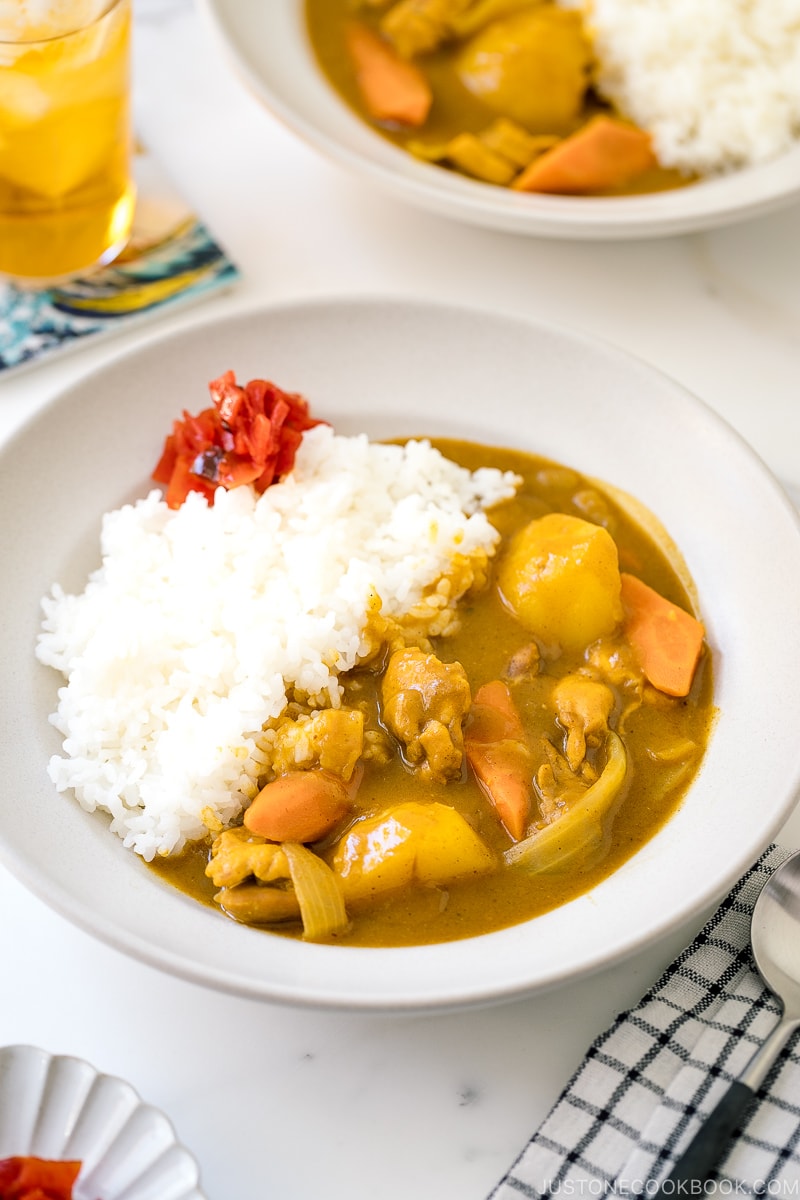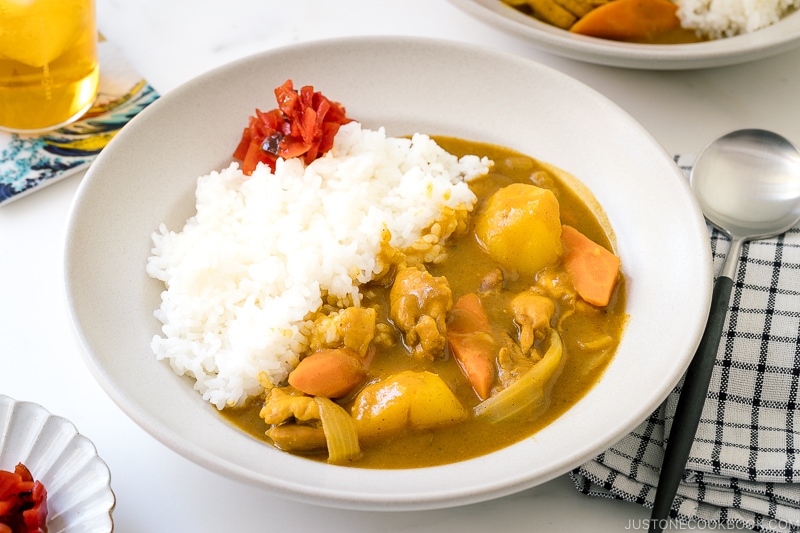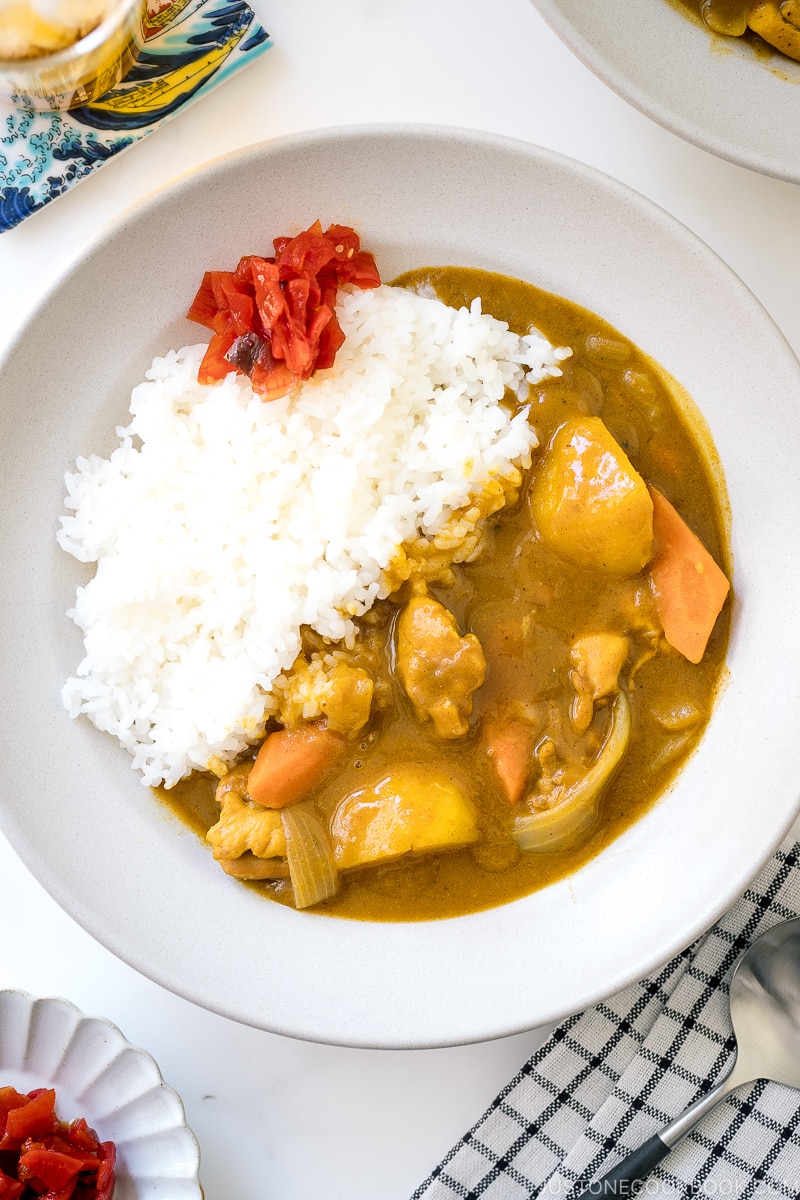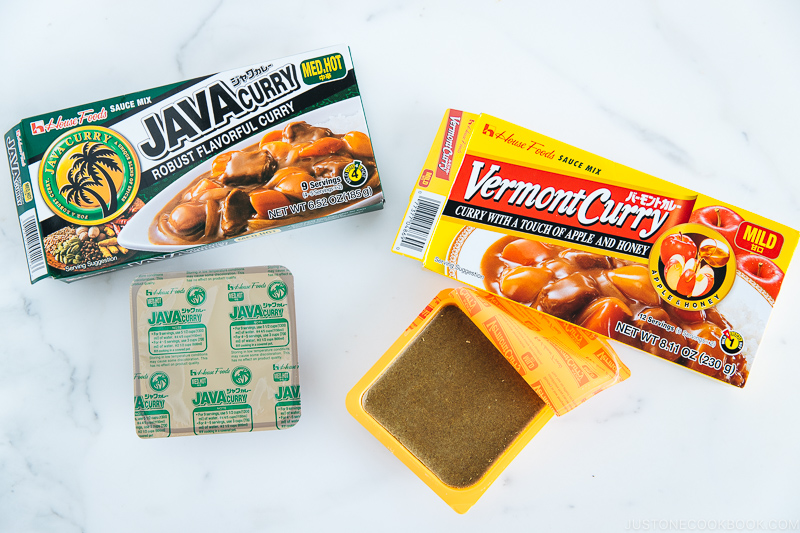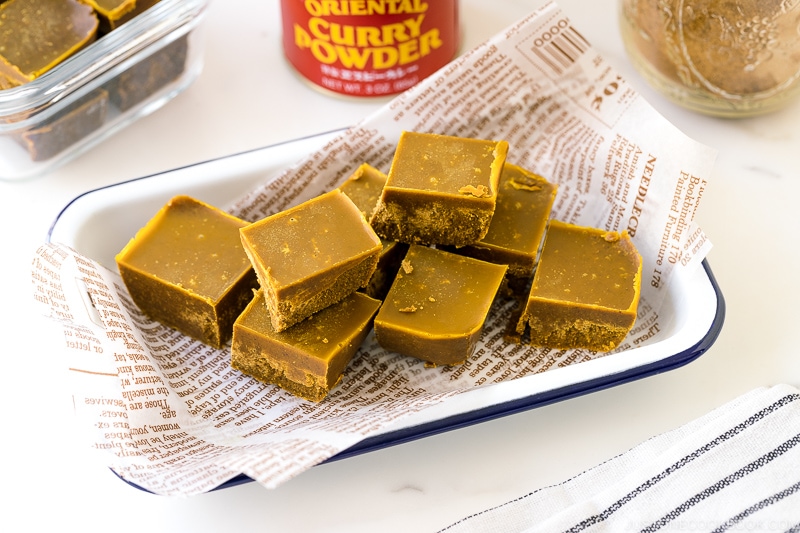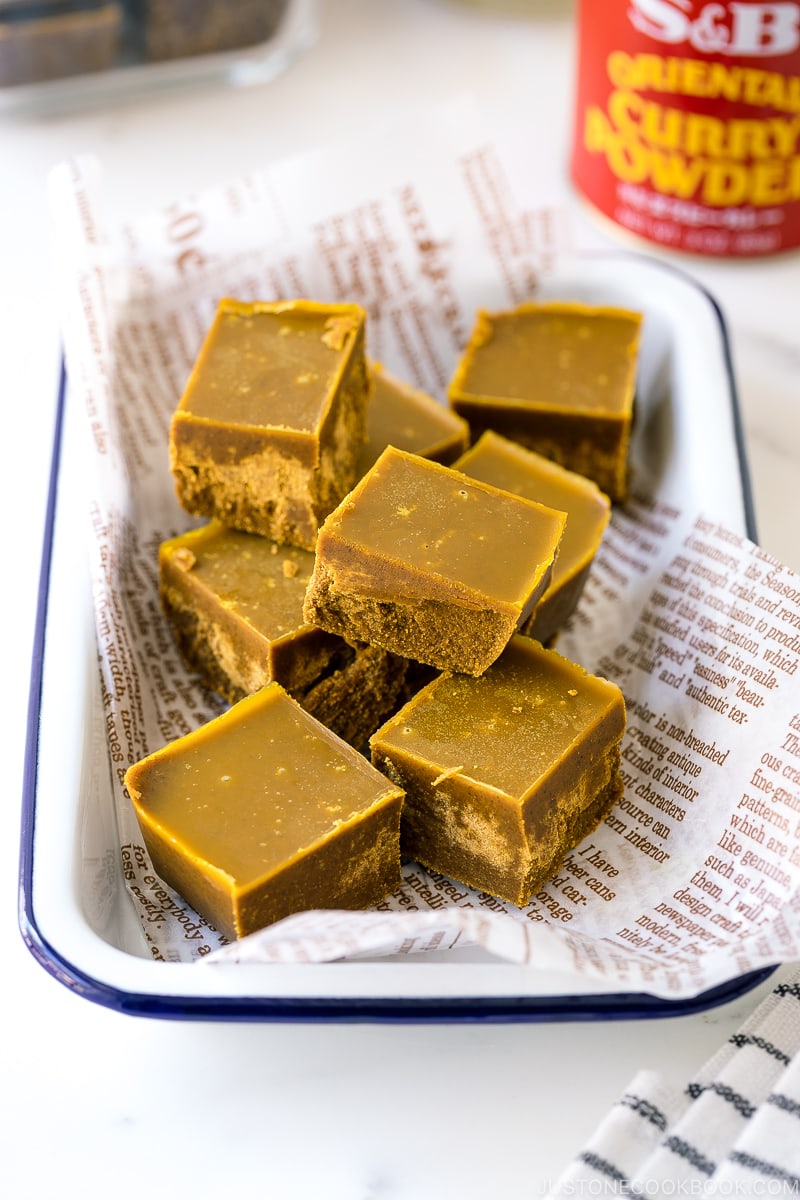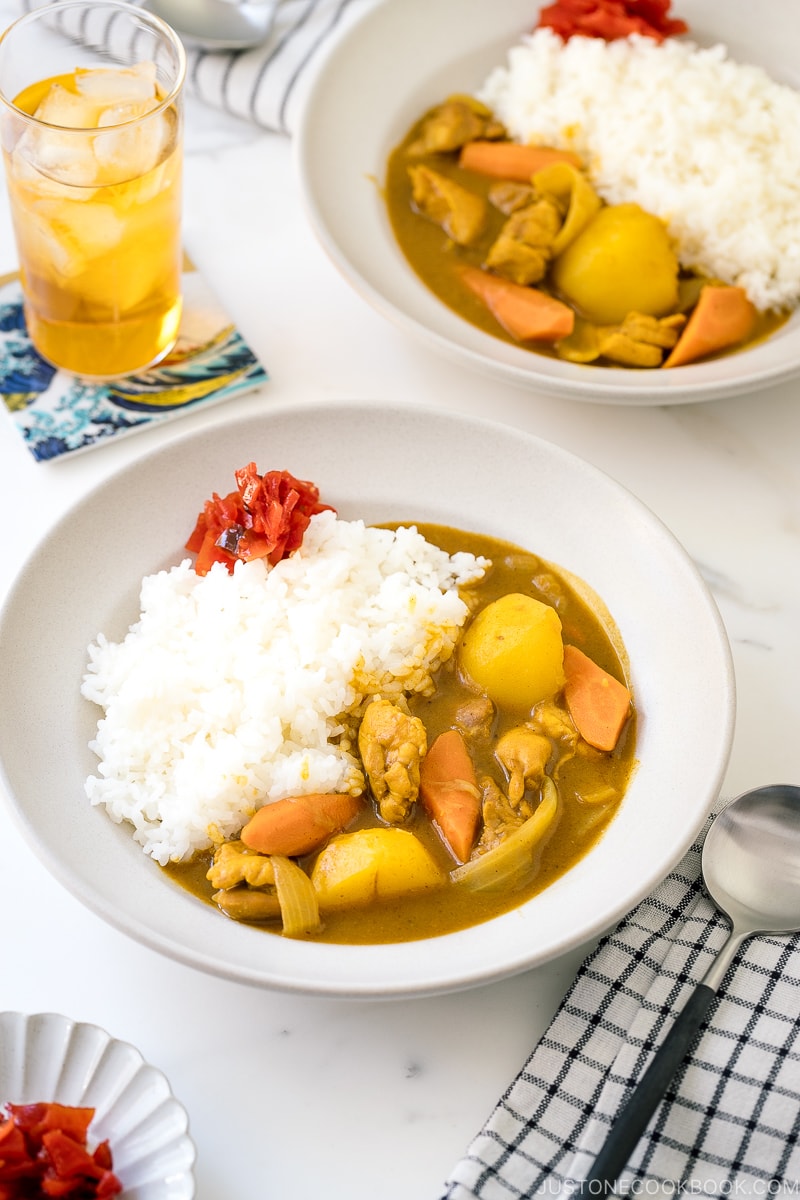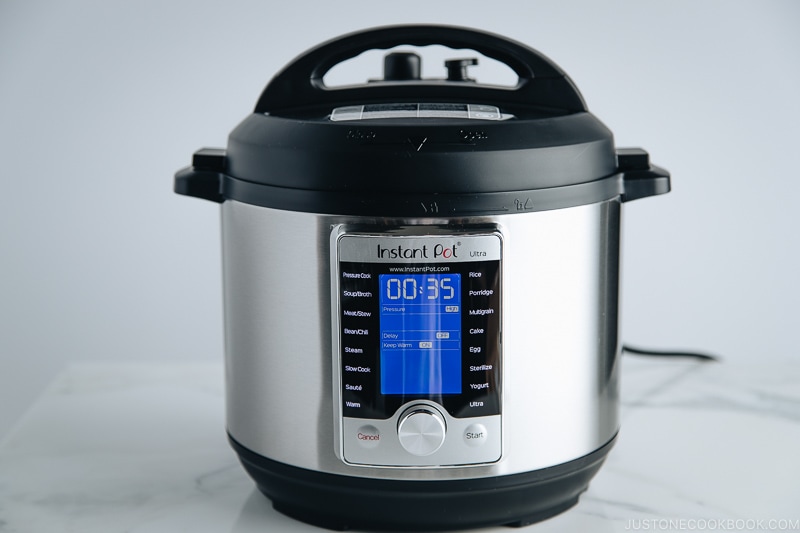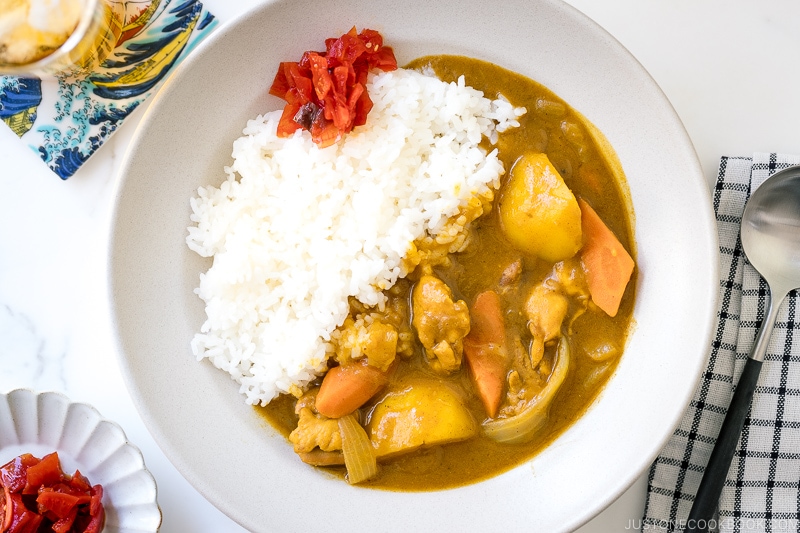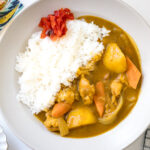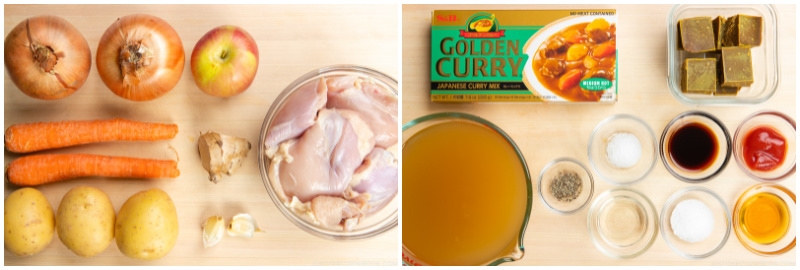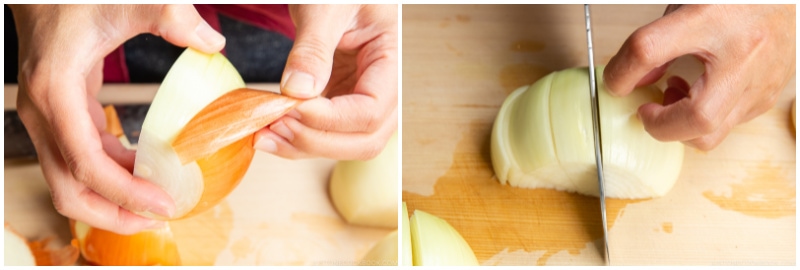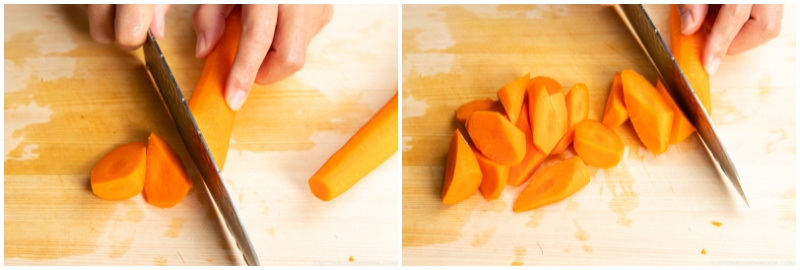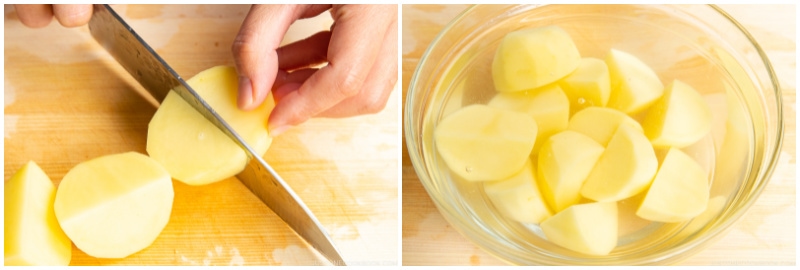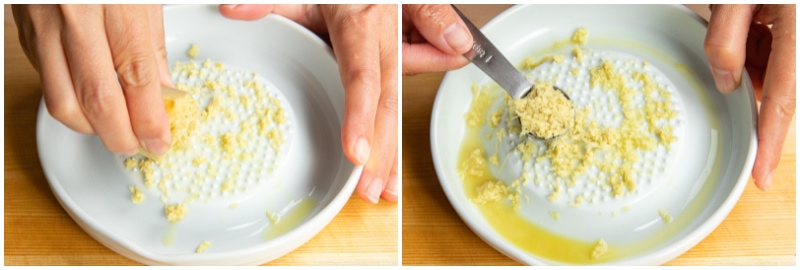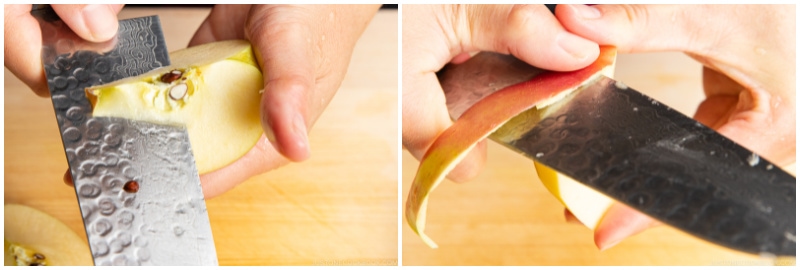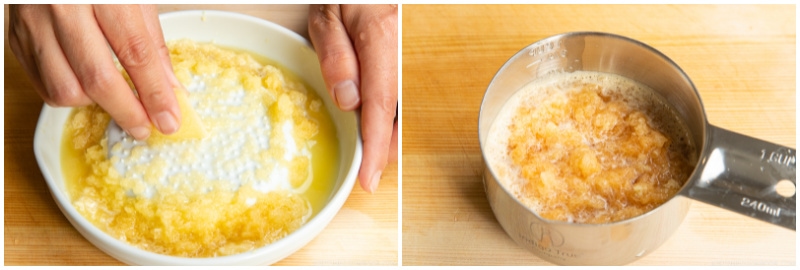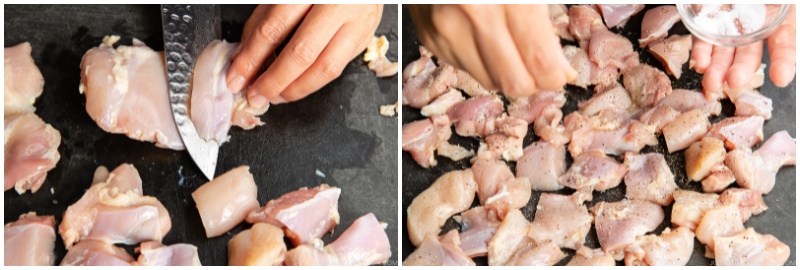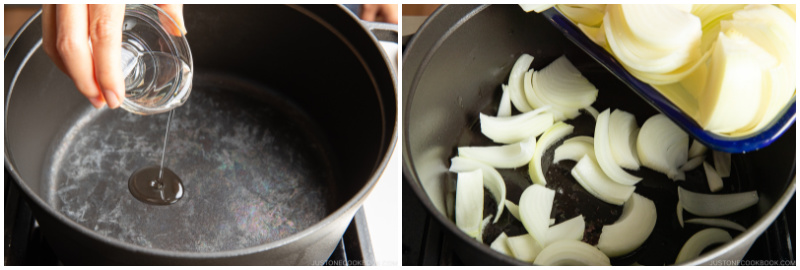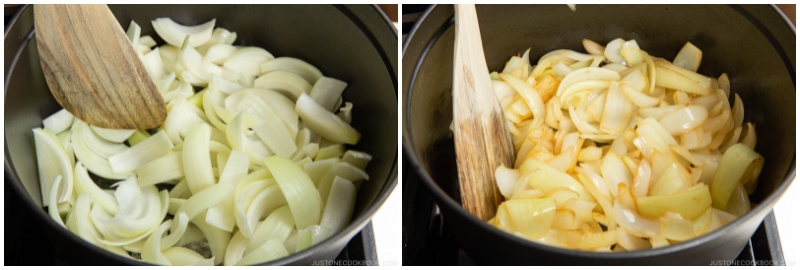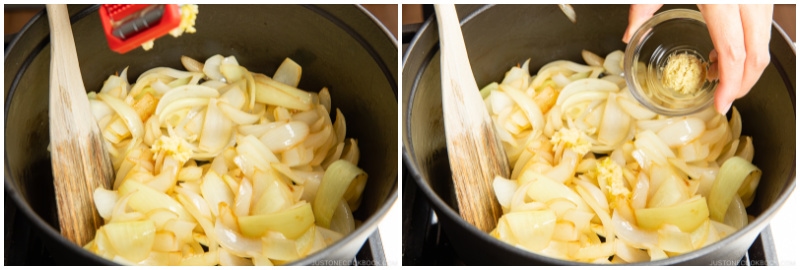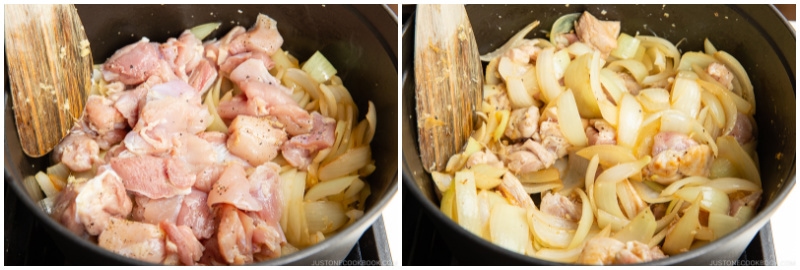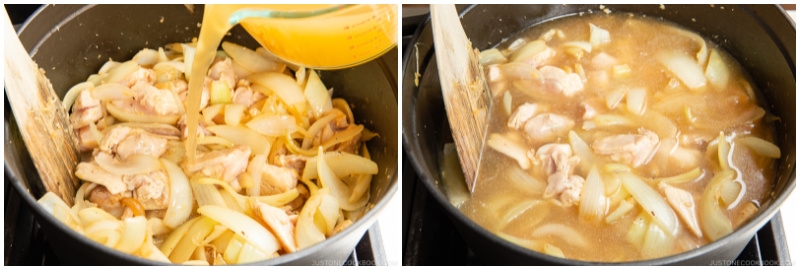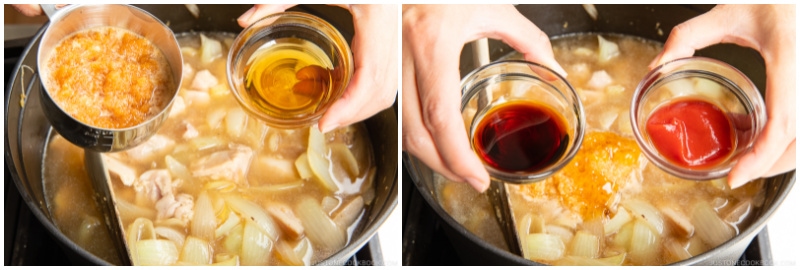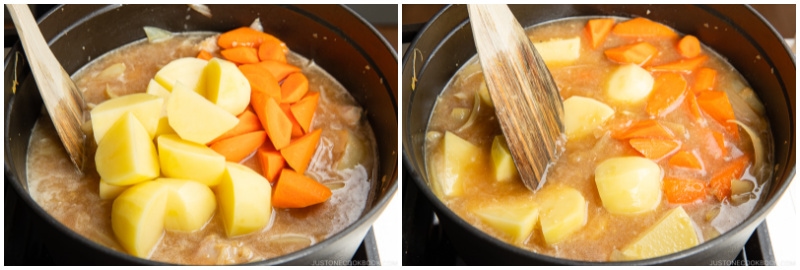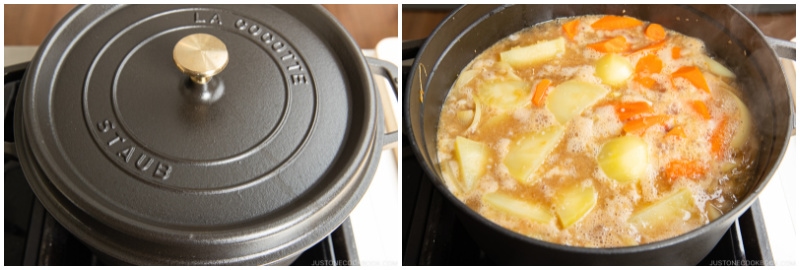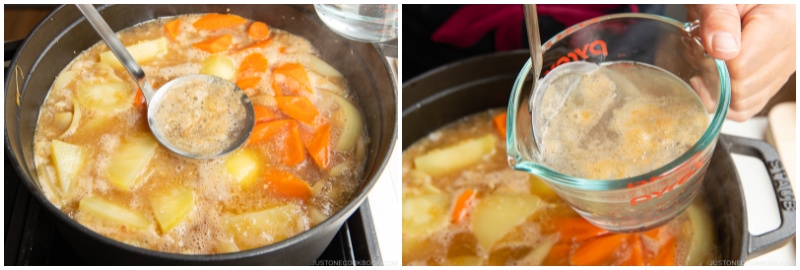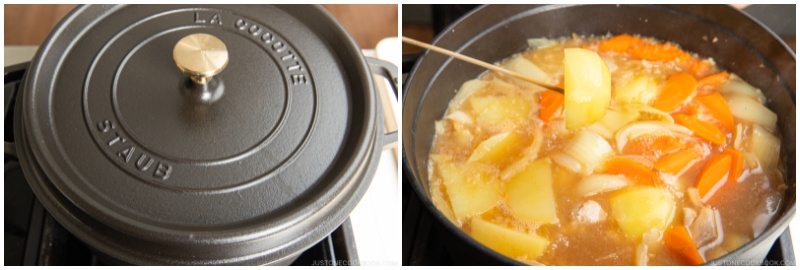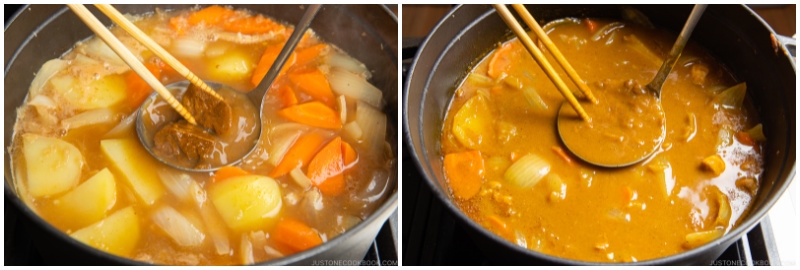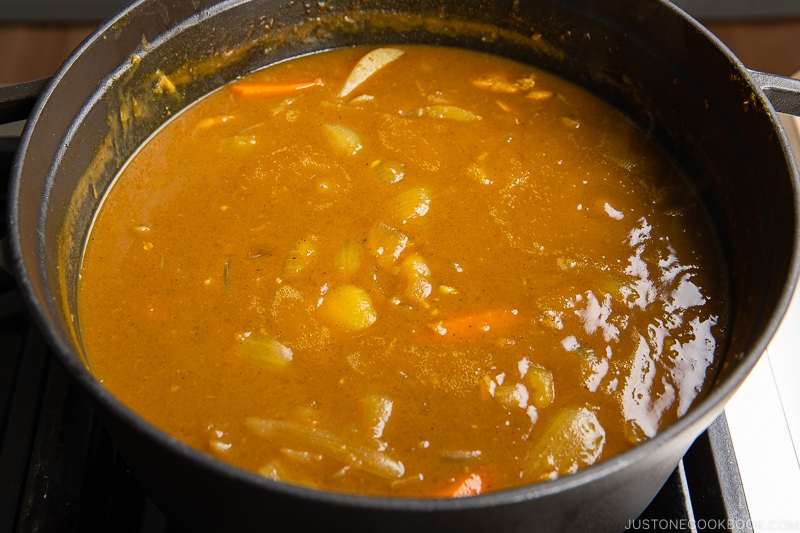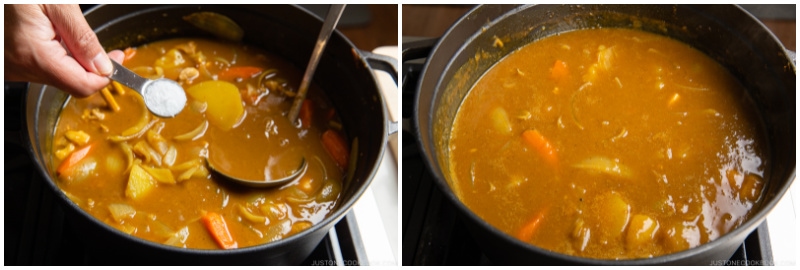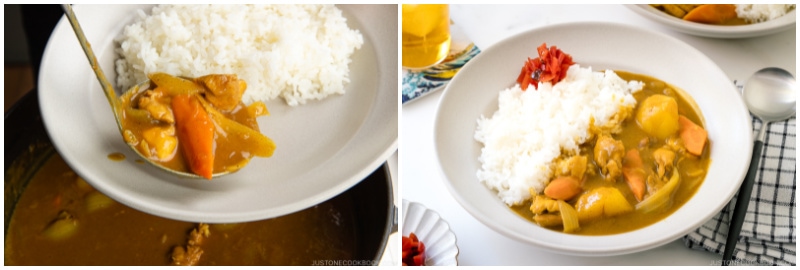This may come as a surprise, but Japanese Curry, aka Curry Rice (Kare Raisu, カレーライス), is an exemplary comfort food and one of the most-loved home-cooked dishes in Japan. I grew up on curry rice, as my mom would make it as frequently as I can recall. The bite-sized chunks of meat, the thick-cut vegetables, the rich and creamy brown curry sauce, and the fluffy rice make every bite so comforting and exciting. Not only is it a meal that’s easy to make on busy nights, but it also tastes better on the second day. So, if you wish to master Japanese home cooking, you must add Japanese curry to your repertoire. Let me show you how to make Japanese Chicken Curry (チキンカレー) today!
What is Japanese Curry?
Japanese curry is a thick curry with a stew-like consistency and commonly includes protein, sweet onions, carrots, and potatoes. The sauce is thickened by a roux (a mixture of fat and flour and an addition of curry spices). You can find many variations of Japanese curries, ranging from regions to households, but the most basic one uses chicken, which is the recipe I’m sharing here. Don’t miss my Japanese curry recipes roundup, which includes vegetarian curry and more!
History of Japanese Curry
Curry was introduced to Japan in the late 1800s by the British, and they were initially Western-style stews mixed with curry powder. The Japanese adapted curry to their own version, and ‘Curry Rice’ (Kare Raisu, カレーライス) was born soon after. By the 1950s, S&B Foods developed a convenient instant mix — known as curry roux — in block form so everyone could make curry rice easily at home. Today, curry has become a staple of the Japanese home and is widely available in restaurants and food halls in departmental stores. The popularity extends beyond Japan; you can find its presence in many other Asian countries.
What Makes Japanese Curry Different from Other Curries
Japanese curry is quite different from most other curries worldwide — it has a thicker consistency, and the taste leans on the sweet and savory side. The unique sweetness comes from onions, carrots, and other additions like honey and grated apples. The sauce resembles a rich, thick demi-glace layered with spices and earthy flavors. Some would describe Japanese curry more like a hearty stew than a typical curry like Thai or Indian. It isn’t spicy, so it is suitable for children. It’s also served with Japanese short-grain rice, which is sticker than basmati rice or long-grain rice. The rice grains also soak up the curry.
The Base Flavor – Japanese Curry Roux
The reason why we can make Japanese curry in a short time is that we use the convenient Japanese Curry Sauce Mix (curry roux カレールー) that comes in a box. The curry roux imparts a unique depth of aromatic spice flavor and creaminess to the dish. I’m not a big fan of “instant” or boxed food, but I have to say Japanese Curry Roux is an exception!
Spice Level
Each brand of curry roux usually comes with three levels of spiciness — Mild, Medium, or Hot. Since these are packaged for Japanese taste, the hot level is not nearly as spicy as Thai or Indian curry.
Too Salty?
Some of you may find the pre-boxed curry roux salty, and I agree. It does have a strong (salty) taste, which is why it goes well with plain steamed rice. The Japanese palate, in general, is gravitated to salty, savory foods. Here are my suggestions:
Make my homemade curry roux. Use water or half water half chicken stock instead of all chicken stock (because the saltiness of the stock varies). Use less curry roux. Add more water to dilute the roux, but note that the curry sauce will be more watery.
Homemade Japanese Curry Roux
Although the boxed stuff may spare you some time in the kitchen, you’ll be surprised at how easy it is to make your own Japanese Curry Roux at home. And just like all curries, curry roux is best made from scratch. What are the other good reasons for homemade roux?
No MSG, artificial flavors, or other food additives are commonly found in boxed mixes. You can customize the flavor, spice level, salt level, and thickness. You can also make it gluten-free or vegetarian/vegan-friendly.
If you decide to make the Curry Roux from scratch, it only takes 30 minutes. Click here for the recipe.
Secret Ingredients – Personalize Your Curry
My mom always adds some grated apples and different condiments to the curry. She says, “If you use just the boxed curry roux, your curry will always taste the same. It will not be different from your neighbor’s curry.” So she taught me two tricks. 1) Use two different brands of curry roux – you can even mix the spice levels, like mild and medium spicy. 2) Use additional seasonings. My mom and I would use a few combinations of the following ingredients to enhance the flavor and give some complexity to the curry. Sweet Taste
- Use 1-3 tsp of secret ingredients to start. These are supposed to be “secret” ingredients and you don’t need to add a lot of it.
- Add the secret ingredients with the broth/water and cook together.
Chutney Grated apple Honey (Amylase in honey breaks starch and causes viscosity loss; therefore, add honey with broth and cook it. Do not add it after the curry roux as the curry will become watery.) Ketchup Mashed banana Mirin Orange/Apricot jam
Refreshing/Sour Taste
Lemon (Add right before serving) Tomato Yogurt
Spicy Taste
Red chili pepper Black pepper Cayenne pepper
Fragrance
Cumin Bay leaf Cinnamon Curry leaves
Umami and Depth
Butter (Add with roux) Chocolate (Add with roux) Garlic cloves (Add while sauteeing) Fresh ginger (Add while sauteeing) Instant coffee Milk (Add with roux) Oyster sauce Red wine Sake Soy sauce Tonkatsu sauce or Worcestershire Sauce
8 Helpful Tips to Make Japanese Chicken Curry
Tip #1: Cut ingredients into uniform shape
This helps to cook everything evenly at the same time.
Chicken: I recommend a Japanese cutting technique called sogigiri (そぎ切り), which slices the ingredient at an angle for more surface area. Onions: I cut into thick wedges for additional texture. Carrots: It takes time to cook carrots, so I recommend another Japanese cutting technique called rangiri (乱切り), which is a rotating cut. You rotate the ingredients as you cut. This creates a more open surface. Potatoes: I recommend Yukon gold potatoes for curry if you prefer to keep the potato shape in the final presentation. Russet potatoes tend to get dissolved by the end of cooking. Cut into 2 inches (5 cm) size, which is ideal.
Tip #2: Cook the onion till tender and golden
The nicely browned onions add a ton of flavor to the final curry. If you have an additional 5-10 minutes, caramelize the onion.
Tip #3: Cover the ingredients with just enough broth (or water)
When you add the broth/water, be sure the ingredients are covered with enough water and not submerged completely. The “barely covering” situation is called hita hita (ひたひた) in Japanese. The ingredients will release more moisture into the cooking liquid as you simmer.
Tip #4: Add “Secret Ingredients” to the broth
Add your ‘secret ingredients’ with the broth before you bring everything to a simmer, before adding the curry roux.
Tip #5: Do not forget to skim
Skimming is a significant step in Japanese cooking. We skim the scum and impurities to achieve a refined taste. Get a fine mesh skimmer and fill up the measuring cup with water. Skim the impurities and dunk the skimmer in the water to clean. Repeat until the broth is clean.
Tip #6: Add two cubes of curry roux at a time
Make sure all the curry roux cubes are dissolved completely. You don’t want to bite into a chunk of curry cube while eating! Fill up a ladle with broth and add two cubes. Using a spoon or chopsticks, let the roux dissolve completely. Then, add two more cubes and repeat.
Tip #7: Watch out when simmering curry
Always watch the curry after you add the roux. The thick curry sauce gets burnt easily at the bottom of the pot.
Need to simmer uncovered for 10 minutes after adding curry roux. Use low heat to simmer. Stay in the kitchen, and keep stirring!
Tip #8: Make a big batch and store
Japanese curry is ideal for freezing. I often cook up a big batch of leftovers and keep them in the refrigerator for a few days or in the freezer for up to a month. Oh, one more thing! Starches like potatoes and sweet potatoes will change their texture after freezing, so remove them if you plan to freeze the curry.
Make Japanese Curry in a Pressure Cooker
Do you own an Instant Pot or a pressure cooker? You can also prepare this comfort dish using my Instant Pot (Pressure Cooker) Japanese Curry recipe.
What to Serve with Japanese Curry
We typically serve the Japanese curry over rice alongside fukujinzuke, a relish made of finely chopped vegetables such as daikon, eggplant, and lotus root, pickled in a soy sauce-based liquid. It will warm you right up! I hope you enjoy this delicious Japanese Chicken Curry recipe!
More Delicious Japanese Curry Recipes
Japanese Beef Curry Instant Pot Japanese Curry Curry Udon Katsu Curry Cold Curry Udon
Wish to learn more about Japanese cooking? Sign up for our free newsletter to receive cooking tips & recipe updates! And stay in touch with me on Facebook, Pinterest, YouTube, and Instagram. Editor’s Note: The post was originally published on Mar 19, 2013. The blog content has been updated, and new images and new video have been added, and the recipe has been slightly revised in October 2021.
